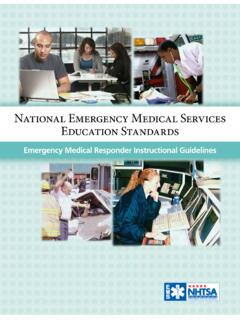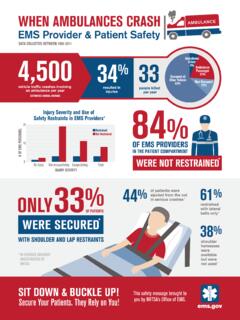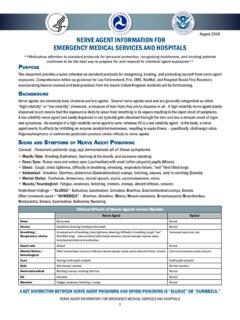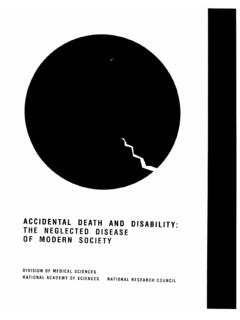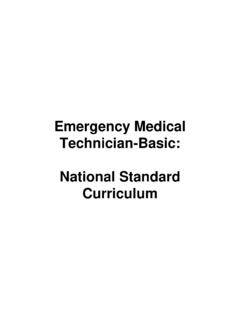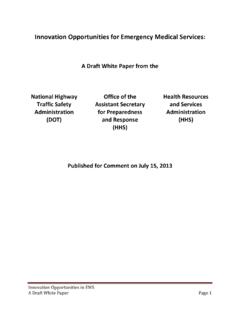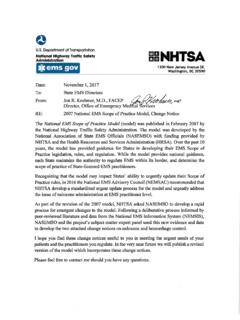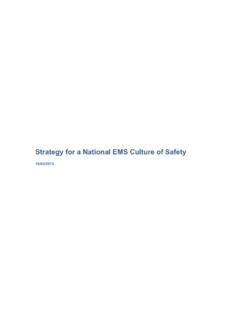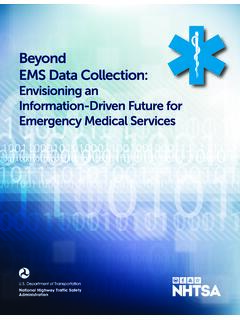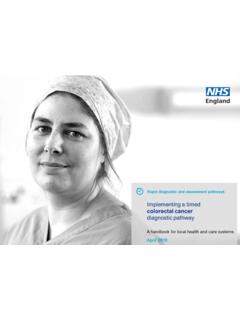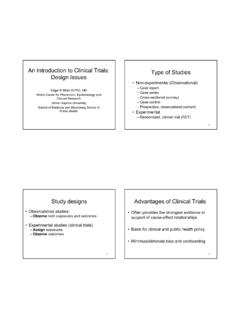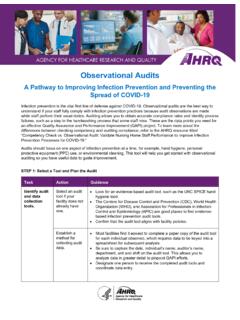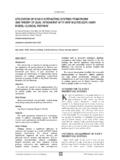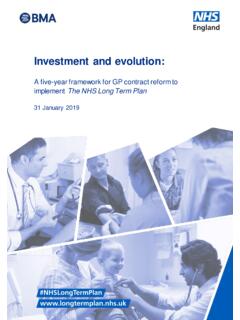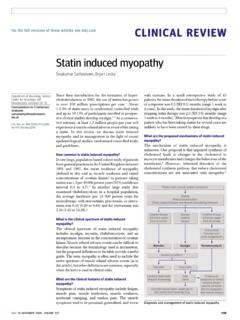Transcription of National Model EMS Clinical Guidelines
1 National Model EMS Clinical Guidelines September 2017 VERSION These Guidelines will be maintained by NASEMSO to facilitate the creation of state and local EMS system Clinical Guidelines , protocols or operating procedures. System medical directors and other leaders are invited to harvest content as will be useful. These Guidelines are either evidence-based or consensus-based and have been formatted for use by field EMS professionals. NASEMSO Medical Directors Council 2 Contents INTRODUCTION ..5 PURPOSE AND NOTES ..6 TARGET AUDIENCE.
2 7 NEW IN THE 2017 EDITION .. 7 ACKNOWLEDGEMENTS .. 7 UNIVERSAL CARE ..8 UNIVERSAL CARE GUIDELINE .. 8 FUNCTIONAL NEEDS .. 16 PATIENT REFUSALS .. 20 CARDIOVASCULAR .. 23 ADULT AND PEDIATRIC SYNCOPE AND PRESYNCOPE .. 23 CHEST PAIN/ACUTE CORONARY SYNDROME (ACS)/ST-SEGMENT ELEVATION MYOCARDIAL INFARCTION (STEMI) .. 27 BRADYCARDIA .. 30 IMPLANTABLE VENTRICULAR ASSIST DEVICES .. 34 TACHYCARDIA WITH A PULSE .. 37 SUSPECTED STROKE/TRANSIENT ISCHEMIC ATTACK .. 43 GENERAL 46 ABDOMINAL PAIN .. 46 ABUSE AND 49 AGITATED OR VIOLENT PATIENT/BEHAVIORAL EMERGENCY.
3 53 ANAPHYLAXIS AND ALLERGIC REACTION .. 60 ALTERED MENTAL STATUS .. 66 BACK PAIN .. 69 END-OF-LIFE CARE/PALLIATIVE CARE .. 72 HYPERGLYCEMIA .. 75 HYPOGLYCEMIA .. 78 NAUSEA-VOMITING .. 83 PAIN MANAGEMENT .. 86 SEIZURES .. 94 SHOCK .. 100 SICKLE CELL PAIN CRISIS .. 106 RESUSCITATION .. 109 CARDIAC ARREST (VF/VT/ASYSTOLE/PEA) .. 109 ADULT POST-ROSC (RETURN OF SPONTANEOUS CIRCULATION) CARE .. 118 DETERMINATION OF DEATH/WITHHOLDING RESUSCITATIVE EFFORTS .. 121 DO NOT RESUSCITATE STATUS/ADVANCE DIRECTIVES/HEALTHCARE POWER OF ATTORNEY (POA) STATUS.
4 124 TERMINATION OF RESUSCITATIVE EFFORTS .. 127 PEDIATRIC-SPECIFIC Guidelines .. 132 BRIEF RESOLVED UNEXPLAINED EVENT (BRUE) .. 132 PEDIATRIC RESPIRATORY DISTRESS (CROUP) .. 142 NEONATAL RESUSCITATION .. 147 OB/GYN .. 151 3 CHILDBIRTH .. 151 ECLAMPSIA/PRE-ECLAMPSIA .. 156 OBSTETRICAL AND GYNECOLOGICAL CONDITIONS .. 160 RESPIRATORY .. 163 AIRWAY MANAGEMENT .. 163 BRONCHOSPASM (DUE TO ASTHMA AND OBSTRUCTIVE LUNG DISEASE) .. 173 PULMONARY EDEMA .. 180 TRAUMA .. 184 GENERAL TRAUMA MANAGEMENT .. 184 BLAST INJURIES .. 190 BURNS.
5 194 CRUSH INJURY .. 198 EXTREMITY TRAUMA/EXTERNAL HEMORRHAGE MANAGEMENT .. 201 FACIAL/DENTAL TRAUMA .. 206 HEAD INJURY .. 209 HIGH THREAT CONSIDERATIONS/ACTIVE SHOOTER SCENARIO .. 214 SPINAL CARE .. 217 TOXINS AND ENVIRONMENTAL .. 225 POISONING/OVERDOSE UNIVERSAL CARE .. 225 ACETYLCHOLINESTERASE INHIBITORS (CARBAMATES, NERVE AGENTS, ORGANOPHOSPHATES) EXPOSURE .. 233 RADIATION EXPOSURE .. 244 TOPICAL CHEMICAL BURN .. 248 STIMULANT POISONING/OVERDOSE .. 252 CYANIDE EXPOSURE .. 256 BETA BLOCKER POISONING/OVERDOSE .. 260 BITES AND ENVENOMATION.
6 264 CALCIUM CHANNEL BLOCKER POISONING/OVERDOSE .. 268 CARBON MONOXIDE/SMOKE INHALATION .. 272 OPIOID POISONING/OVERDOSE .. 276 AIRWAY RESPIRATORY IRRITANTS .. 281 RIOT CONTROL AGENTS .. 290 HYPERTHERMIA/HEAT EXPOSURE .. 293 HYPOTHERMIA/COLD EXPOSURE .. 298 DROWNING .. 306 DIVE (SCUBA) INJURY/ACCIDENTS .. 310 ALTITUDE ILLNESS .. 314 CONDUCTED ELECTRICAL WEAPON INJURY ( TASER ) .. 318 ELECTRICAL INJURIES .. 321 LIGHTNING/LIGHTNING STRIKE INJURY .. 325 APPENDICES .. 331 I. AUTHOR, REVIEWER AND STAFF INFORMATION .. 331 II. PUBLIC REVIEW COMMENT CONTRIBUTORS.
7 338 III. UNIVERSAL DOCUMENTATION GUIDELINE .. 339 IV. MEDICATIONS .. 353 V. APPROVED ABBREVIATIONS .. 370 VI. BURN AND BURN FLUID CHARTS .. 375 4 VII. NEUROLOGIC STATUS ASSESSMENT .. 381 VIII. ABNORMAL VITAL 382 IX. EVIDENCE-BASED Guidelines : GRADE METHODOLOGY .. 383 X. 2011 Guidelines FOR FIELD TRIAGE OF INJURED PATIENTS .. 384 5 Introduction The inaugural edition of the National Association of State EMS Officials (NASEMSO) National Model EMS Clinical Guidelines was released in September 2014 and has been warmly welcomed by EMS practitioners, agencies, medical directors, and healthcare organizations in our nation as well as abroad.
8 The creation of this document was a pinnacle event in the profession and medical practice of EMS as it fulfilled a recommendation in The Future of Emergency Care: Emergency Medical Services at the Crossroads published by the Institute of Medicine (now the National Academies of Sciences) in 2007. Specifically, this report states NHTSA, in partnership with professional organizations, should convene a panel of individuals with multidisciplinary expertise to develop evidence-based Model prehospital care protocols for the treatment, triage, and transport of patients.
9 The National Highway Traffic Safety Administration s Office of EMS (NHTSA OEMS) has embraced this recommendation with the development of the Evidence-Based Guideline Project and continued support of the NASEMSO National EMS Model Clinical Guidelines . The National Association of State EMS Officials recognizes the need for National EMS Clinical Guidelines to help state EMS systems ensure a more standardized approach to the current practice of patient care and, as experience dictates, adoption of future practices. Model EMS Clinical Guidelines promote uniformity in prehospital care which, in turn, promotes more consistent practice as EMS providers move across healthcare systems.
10 They also provide a standard to EMS medical directors upon which to base practice. Supported by initial and subsequent grant funding from NHTSA OEMS and the Health Resources and Services Administration (HRSA), Maternal and Child Health Bureau s EMS for Children Program, NASEMSO authorized its Medical Directors Council to partner with National stakeholder organizations with expertise in EMS direct medical oversight and subject-matter experts to create a unified set of patient care Guidelines . For the aspects of Clinical care where evidence-based Guidelines derived in accordance with the National evidence-based guideline Model process were not available, consensus-based Clinical Guidelines were developed utilizing currently available research.
